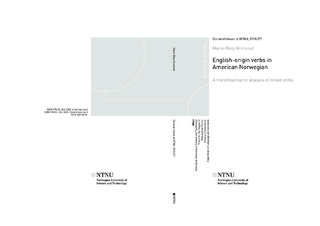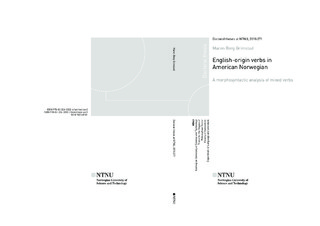| dc.contributor.advisor | Åfarli, Tor Anders | |
| dc.contributor.advisor | Lohndal, Terje | |
| dc.contributor.author | Grimstad, Maren Berg | |
| dc.date.accessioned | 2018-09-28T12:56:43Z | |
| dc.date.available | 2018-09-28T12:56:43Z | |
| dc.date.issued | 2018 | |
| dc.identifier.isbn | 978-82-326-3333-3 | |
| dc.identifier.issn | 1503-8181 | |
| dc.identifier.uri | http://hdl.handle.net/11250/2565255 | |
| dc.description.abstract | Sammendrag av avhandlingen
English-origin verbs in American Norwegian: A morphosyntactic analysis of mixed verbs
“Vi bare satt der og watch-a da”. Dette er ikke eksempel på ungdomsspråk, men sitat fra en 93 år gammel tredjegenerasjons norskamerikaner. Han vokste opp med norsk som morsmål, men har vært dominant i engelsk siden iallfall skolealder. Resultatet er blant annet at norsken hans har mange innslag av engelsk.
I mitt doktorgradsarbeid har jeg studert forekomsten av verb av engelsk opphav i ellers norske ytringer i lydopptak av 50 slike 2.-5. generasjons norskamerikanere med norsk som morsmål. Mens ca. 72% hadde norsk bøyningsendelse, var de resterende bøyd som de ville vært på engelsk. Jeg sammenligner det også med substantiv, der jeg finner tilsvarende mønster.
På bakgrunn av dette argumenterer jeg for en spesifikk type grammatisk analysemodell. Den modelltypen som vanligvis benyttes i formell språkblandingsforskning, såkalt leksikalistisk-minimalistisk type, krever at innholdsord, som ’watch’, blir kopiert fra en engelsk til en norsk liste i hjernen for at de skal kunne få norsk bøyningsendelse. Jeg argumenterer imidlertid for at man fint kan si ”Vi bare satt der og watch-a da”, men likevel oppfatte ’watch’ som et engelsk ord; og det passer dårlig med at det nå skal være lagret som et norsk ord. I den eksoskeletale modelltypen jeg støtter, er imidlertid innholdsord lagret uten språkspesifikke grammatikkdetaljer, og de trenger derfor ikke lagres i språkspesifikke lister.
Ettersom tidligere språkblandingsforskning tilsa at bortimot alle disse verbene ville ha norsk bøyningsendelse, diskuterer jeg også hvorfor jeg finner en såpass høy andel som er bøyd som på engelsk. Konklusjonen er at dette handler om at mine informanter ikke er like flinke i norsk som i engelsk, mens tidligere forskning har studert språkblandingen til forholdsvis balanserte flerspråklige. Min forskning viser derfor også at en korrekt grammatikkmodell må kunne gjøre rede for begge disse blandingsmønstrene, noe ikke alle gjør. Jeg diskuterer også hvilke termer vi trenger for å beskrive språkblandingsmønstrene. | nb_NO |
| dc.description.abstract | Summary of the thesis
English-origin verbs in American Norwegian: A morphosyntactic analysis of mixed verbs
“Vi bare satt der og watch-a da” (We just sat there and watch-past then). This is not youth lingo, but rather a quote from a 93-year-old third generation Norwegian American. He grew up with Norwegian as his native language, but has been dominant in English since at least school age. One consequence is that his Norwegian displays many English loans.
In my ph.d. work I have studied verbs of English origin in otherwise Norwegian utterances in recordings of 50 such 2nd to 5th generation Norwegian Americans who are native speakers of Norwegian. While about 72% had Norwegian inflections, the rest were inflected as they would have been in English. I also compare with nouns, where I find the same overall pattern.
Based on this I argue for a specific grammar model. The model type mostly used in formal language mixing research, i.e., a lexicalist-minimalist type, requires content words like ‘watch’ to be copied from an English to a Norwegian list in the brain in order to receive Norwegian inflection. I argue that you can say “Vi bare satt der og watch-a da” and still think of ‘watch’ as an English word, and that is difficult to reconcile with ‘watch’ being stored as a Norwegian one. In the exoskeletal model type I support, however, content words are stored without language specific grammar details, removing the need to store them in language-specific lists.
As former language mixing research suggested that all of these verbs should have had Norwegian inflections, I also discuss why I found such a high percentage that are inflected as in English. The conclusion is that this has to do with my informants not being as proficient in Norwegian as in English, while previous research has studied the language mixing of fairly balanced bilinguals. My research therefore shows that a correct grammar model should be able to account for both of these mixing patterns, something which not all do. I also discuss what terms we need to describe these language mixing patterns. | nb_NO |
| dc.language.iso | eng | nb_NO |
| dc.publisher | NTNU | nb_NO |
| dc.relation.ispartofseries | Doctoral theses at NTNU;2018:271 | |
| dc.relation.haspart | Paper 1: Language Mixing and Exoskeletal Theory A Case Study of Word-Internal Mixing in American Norwegian - Is not included due to copyright available in Formal Grammar: Theory and Variation across English and Norwegian. Routledge 2017 (ISBN 9781138289697) | nb_NO |
| dc.relation.haspart | Paper 2: Grimstad, Maren Berg; Riksem, Brita Ramsevik; Lohndal, Terje; Åfarli, Tor Anders. Lexicalist vs. exoskeletal approaches to language mixing. The Linguistic Review 2018 ;Volum 35.(2) s. 187-218
https://doi.org/10.1515/tlr-2017-0022. | nb_NO |
| dc.relation.haspart | Paper 3: Grimstad, Maren Berg. The code-switching/borrowing debate: Evidence from English-origin verbs in American Norwegian. Lingue e linguaggio 2017 ;Volum XVI.(1) s. 3-34
Is not included due to copyright available at
https://doi.org10.1418/86999 | nb_NO |
| dc.title | English-origin verbs in American Norwegian: A morphosyntactic analysis of mixed verbs | nb_NO |
| dc.type | Doctoral thesis | nb_NO |
| dc.subject.nsi | VDP::Humanities: 000::Linguistics: 010::Nordic languages: 018 | nb_NO |

